Gold still looks good – but miners look even better
In the scramble to buy gold, gold mining stocks have been largely forgotten. That's about to change, says Simon Popple. Here, he tips three cheap gold miners to buy now.
Have you ever sat down and worked out your personal inflation rate? I have. The latest official statistics suggest that the consumer price index (CPI the Bank of England's official target' measure) rose at an annual rate of 2.8% in May. But I reckon my cost of living has risen by a lot more.
Having looked at all my costs and I mean all, from the 5.8% rise in the price of a kilogramme of tomatoes, to the 2.4% rise in the price of a loaf, to the 6% rise in the cost of filling upmy car, to the whopping 14% rise in the cost of a bag of potatoes I reckon my annual inflation rate is sitting at more than 6% 6.3% to be exact.
The chances are, unless you live with your parents and spend most of your income on new electronic goods (which are about the only things that consistently fall in price these days), your own cost of living is probably rising at a similar rate.
MoneyWeek
Subscribe to MoneyWeek today and get your first six magazine issues absolutely FREE

Sign up to Money Morning
Don't miss the latest investment and personal finances news, market analysis, plus money-saving tips with our free twice-daily newsletter
Don't miss the latest investment and personal finances news, market analysis, plus money-saving tips with our free twice-daily newsletter
This isn't an ideal situation. But what makes it even worse is the fact that the rate I'm getting on my cash savings isn't anything like 6%. With the average annual pay rise for a British worker coming in at a mere 0.6% in the first quarter of 2012, most people's wages aren't keeping up with their costs either.
There's a good reason for this. As I'll explain below, encouraging just enough' inflation while holding down savings rates is a key part of the government and central banks' strategy to bail out debtors and try to get out of the economic hole we're in. In other words, don't expect the squeeze to let up.
What can you do? Everyone needs an easily accessible pot of cash savings there's no substitute for that, even in today's environment. But when it comes to your long-term retirement pot, you need to be aware of the threat that inflation poses to your wealth. Buying physical gold as portfolio insurance is a step in the right direction. But I think there's a better way to invest in gold.
Compared with their long-term track records, gold and silver miners now look cheap relative to gold. And there's a very specific type of miner that looks particularly attractive in this environment. I'm talking about miners which are generating healthy cash flows.
We'll go into why this is so important in just a moment, but the fact is that some of these stocks have significantly underperformed the gold and silver spot prices. That means thatthey offer huge potential upside.
In fact, over the last three years I've been diverting my savings into gold miners, favouring those listed in two countries: Canada and Australia. I'm convinced that these are the best assets to buy at this stage of the financial crisis. Here's why.
The authorities are in a deep hole
Regardless of what politicians or central bankers or the press might say about stimulating' an economic recovery, there's very little that anyone in the Western world can do at this stage. The closet is bare. Interest rates are at all-time lows, which makes monetary policy less effective.
Meanwhile, on the fiscal side, governments aren't in any position to cut taxes. In fact, they want to take even more of our money to reduce the huge debts that they're carrying. So while once, in the decades before the financial crisis, vote-hungry governments would have been able to ease our pain and put more money in our pockets by cutting interest rates, taxes, or both, now they can't.
So what's the alternative? To inflate our way out. The trouble is, you don't want to be too blatant about it. The investors who are buying your debt might put up with a bit of inflation while they're more scared of capital losses. But if it becomes clear that you are trying to repay your debts with devalued money, you might attract the dreaded bond vigilantes', driving up interest rates on your debt.
So naturally the government wants to report inflation in the best possible light. It's so desperate to keep it low that it recently switched from using the retail (RPI) to the consumer price index (CPI) when calculating annual changes to tax credits, certain benefits and public-sector pensions. It's done this because RPI usually shows a higher rate of inflation than CPI.
It may not seem like much of a gap on a year-to-year basis (RPI is typically 0.5-0.8 percentage points higher than CPI), but over a longer period of time this can make a vast difference, particularly for anyone whose pension, benefits, wages or commercial contract is indexed to RPI rather than CPI.
If we look back over the 15 years since CPI was introduced, the cumulative inflation rate shown by RPI (since 1996)
is 53.6% while that for CPI is 35.6%.
So a private pensioner who retired in 1996 and whose pension had been uplifted by RPI would now be 13% better off than a notional person starting on a similar pension uplifted by CPI.
You can expect these attempts to understate the inflation rate to continue. It's all part of the financial repression' gameplan. Without interest-rate cuts and tax cuts, growth can't be stimulated. So the only way out of our debts is either to default or inflate our way out.
As I've already noted, I think the government will choose the latter. I think we'll see another round of quantitative easing (QE) this year. And that may not be the end of it. With Europe teetering on the brink, I would very much advise you to have a strategy in place sooner rather than later to protect whatever purchasing power you have left.
It's not too late to invest in gold
That's why you need to buy gold. "Great," I hear you say, "you're ten years too late." You only have to take a look at the chart below to see what I mean. As gold is typically priced in US dollars, I've used some American data that appear to show adjusted using the current US Bureau of Labor statistics (BLS) consumer price index (CPI) that the 2011 high in the gold price was similar to the bubble of 1980. It certainly looks like a bubble about to burst.
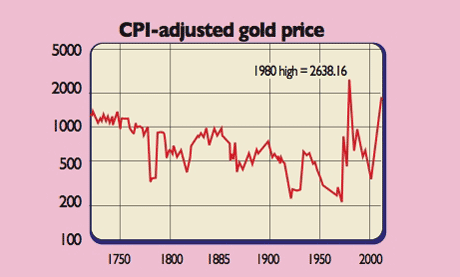
So why would I recommend you stick with gold? Because you've been duped. Since 1980, gold's last major peak, the BLS has changed the way that American CPI is calculated. Among other things, the changes allowed for substitution of lower-priced and lower-quality goods in the basket that is used to measure inflation (for example, substituting hamburgers for steaks when steak prices rise).
If you take CPI as it would have been without the changes, then gold and silver prices adjusted for inflation do not appear to have been anywhere near bubble levels in 2011, according to John Williams of Shadow Government Statistics (SGS), as the second chart shows.
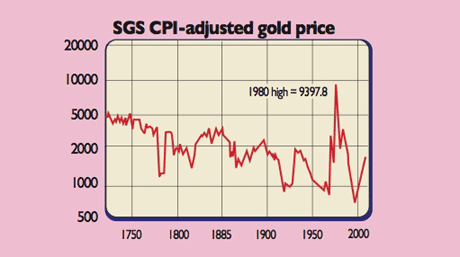
So although gold may not be cheap, if history repeats itself it's likely to become a lot more expensive. If you don't have any, you may just regret it, for five reasons.
Gold isn't just an inflation hedge, but it does tend to do well as inflation takes off. As governments continue to crank up the printing presses, flooding the economy with paper money, and as national debt continues to rise, there is no question in my mind that sooner or later, inflation will roar back with a vengeance.
Sterling will be devalued. There's a race to the bottom between governments in the West in particular, most of whom are committed to printing enough money to keep the global economy afloat. So sterling, the dollar and eventually the euro will all be devalued. After all, the only way for these countries ever to repay their debts without defaulting is to repay them with devalued money. Gold is the best way to protect yourself.
Gold is money. Throughout recorded history, gold has been an accepted means of exchange worldwide. It fulfils the four criteria for money: it's divisible, portable, durable, and its supply is limited. While world gold production has been rising since 2008, it is still below its 2001 peak. Of the eight largest gold-producing countries in the world, six have declining production and thus are bringing fewer and fewer ounces to the market every year. This decrease in global gold production will underpin the bull market for years.
Demand is skyrocketing. Central banks have been net buyers of gold since 2009. India and China are also increasing their gold purchases. According to the World Gold Council, the countries' demand for gold is growing ever more rapidly: for example, demand grew by 38% in the second quarter of 2011, compared to the 25% growth seen in the same period in 2010. Together they account for 52% of all investment demand for gold. Similarly the US Mint frequently has to suspend sales of its more popular coins due to overwhelming demand.
Institutional investors are increasingly taking part in the gold market. In April last year, the University of Texas announced that its endowment fund (the second-largest in the country next to Harvard's) had taken possession of a billion dollars' worth of physical gold. The gold market is small compared to the bond, real estate and equity markets. It's therefore far more sensitive to money entering and leaving it.
The cheapest way to buy gold now
Yet despite this insatiable appetite for the yellow metal worldwide, the companies that produce the stuff have not been appropriately rewarded. Their stock prices remain relatively inexpensive relative to gold. That will change. As gold moves steadily higher, I believe that gold stocks will start to catch up. Take a look at the 30-year chart below. This shows courtesy of James Turk the XAU Gold Mining Index (an index of 16 precious metal miners) measured in terms of gold, rather than dollars.

As you can see, gold stocks have never before been this undervalued relative to the price of the metal they produce.
We may have had a 12-year bull market in gold, but measured in gold terms it's been accompanied by a 15-year bear market in mining shares. When this turns around, the potential upside could be extraordinary. So which miners are best placed to prosper most?
The key is getting exposure to producers those who are actually getting gold out of the ground. There will also be some spectacular returns from explorers, but it's far more difficult to find the winners and all too easy to find some big losers in that sector.
Should more institutions start to show an interest in the sector and increase or start to make allocations, then the vast majority will be looking at producers rather than explorers, which are likely to be viewed as too risky. This potential wall of money would add a further significant boost to prices.
Of the producers, you are looking for companies with the following three characteristics. Firstly, you want to see a combination of growing revenue streams and effective cost controls. Expansion is all very well, but not if the profits get eaten up by extra costs. Secondly, you want to minimise political risk by buying producers with properties in areas where mining activity is actively welcomed. Thirdly, you want to see healthy cash flow being generated.
This last point is particularly important for one reason. If we see a major banking crisis this year or next (and with Europe still on the edge, it's by no means out of the question), it will be very difficult for many gold miners to secure funding.
So what you want is a company that already has sufficient cash, meaning that it won't have to go to capital markets to secure funding. You want a miner that is generating enough cash to fund future exploration, or even to pay a healthy dividend to investors.
Why Canada and Australia?
These criteria narrow the field massively. On top of this, I also think it makes sense to favour producers who are listed and operating in Canada and Australia. As a country, Canada is backed by hard assets. It has timber, it has water, and it is fast emerging as a major oil exporter on the back of the tar sands. Its government has also managed to keep a leash on its financial sector. So it isn't likely to have to resort to massive monetary or fiscal stimulus in the next few years.
Australia leads the world in economically recoverable reserves of commodities from nickel to lead, uranium, gold, silver and copper. What's more, the Australian government owns all the mineral wealth in the territory of Australia. So it remains solvent. If China continues to slow down, that will ease inflationary pressures in Australia too removing the pressure on the Reserve Bank of Australia to weaken the Aussie dollar.
Although I'd anticipate the upward trajectory in my precious metal miners' share prices to provide the lion's share of your return, should sterling be hit by any fall out in Europe then exposure to these two currencies could provide some added protection to your portfolio, although bear in mind that the currency risk works the other way too, should they weaken against the pound.
So which stocks should you buy? I've suggested three options to begin with below.
Three gold stocks to buy now
The first stock to consider for your precious metals portfolio is Yamana Gold (TSX: YRI). Yamana has a diversified portfolio of assets providing sustainable gold production supported by a large resource base. It has industry-low cash costs and operations in some of the world's most stable mining jurisdictions. It also hiked its dividend by 10% in February, which makes Yamana's yield, at 1.6%, one of the most attractive in the industry.
Silver Lake (ASX: SLR) is a gold producer and explorer with a resource base of 3.6 million ounces in highly prospective regions, such as Mount Monger and the Murchison goldfields of western Australia. Its strategy is to develop large production centres at Mount Monger and at the Murchison with multiple mines at each centre.
This is a well regarded company it won the Craig Oliver Award at the 2012 RIU Explorers Conference, which goes to an Australian miner that has excelled in areas including exploration, mining, community and environmental work. Prospects are promising and the balance sheet is strong. Half-year audited profit after tax was A$17.2m, up 185% on the same period a year earlier, and the company is debt and hedge free (in other words, it is fully exposed to any changes in the gold price).
Franco-Nevada Corporation (TSX: FNV; NYSE: FNV) is a gold-focused royalty company, which also has interests in platinum group metals and other resources. I like the royalty business model, whereby a company owns part of the revenue stream from a mine in exchange for upfront investment, because it means the company has no exposure to rising capital and production costs, something almost every producer faces. Franco-Nevada has exposure to some of the largest gold discoveries in the world, which has allowed it to raise its dividend every year since it was spun off from Newmont in 2007.
Simon Popple has 20 years of experience in corporate finance, working with clients including Bunge, Bank of China, Hinde Gold Fund and Renewable Tech Ventures. He is working on a precious metals newsletter that will launch later this year.
This article was originally published in MoneyWeek magazine issue number 594 on 21 June 2012, and was available exclusively to magazine subscribers. To read all our subscriber-only articles right away, subscribe to MoneyWeek magazine.
Get the latest financial news, insights and expert analysis from our award-winning MoneyWeek team, to help you understand what really matters when it comes to your finances.
Simon is an expert in investing in gold and commodities which he shares for our MoneyWeek readers. He studied at the University of Surrey where he achieved a business degree and a marketing diploma. After taking his studies further and doing an MBA at Birmingham University, Simon was the first MBA student offered an internship in the U.S. Since then, Simon has been a part of the Senior Banker team at ABN Amro where he became the founding member of their Financial Sponsors team, and then joined Strutt and Parker Financial Services where he was appointed as Head of Investment Management. He also became a director at one of the world’s biggest private property companies, Topland. Simon Popple has written for MoneyWeek and Agora Financial.
-
 The most influential people of 2025
The most influential people of 2025Here are the most influential people of 2025, from New York's mayor-elect Zohran Mamdani to Japan’s Iron Lady Sanae Takaichi
-
 Millions of parents are missing out on up to £720 a year in extra pension cash – are you affected?
Millions of parents are missing out on up to £720 a year in extra pension cash – are you affected?A mum who narrowly missed out on the pension boost said she “never knew the government rule existed” and wants other parents to use it
-
 Why Scotland's proposed government bonds are a terrible investment
Why Scotland's proposed government bonds are a terrible investmentOpinion Politicians in Scotland pushing for “kilts” think it will strengthen the case for independence and boost financial credibility. It's more likely to backfire
-
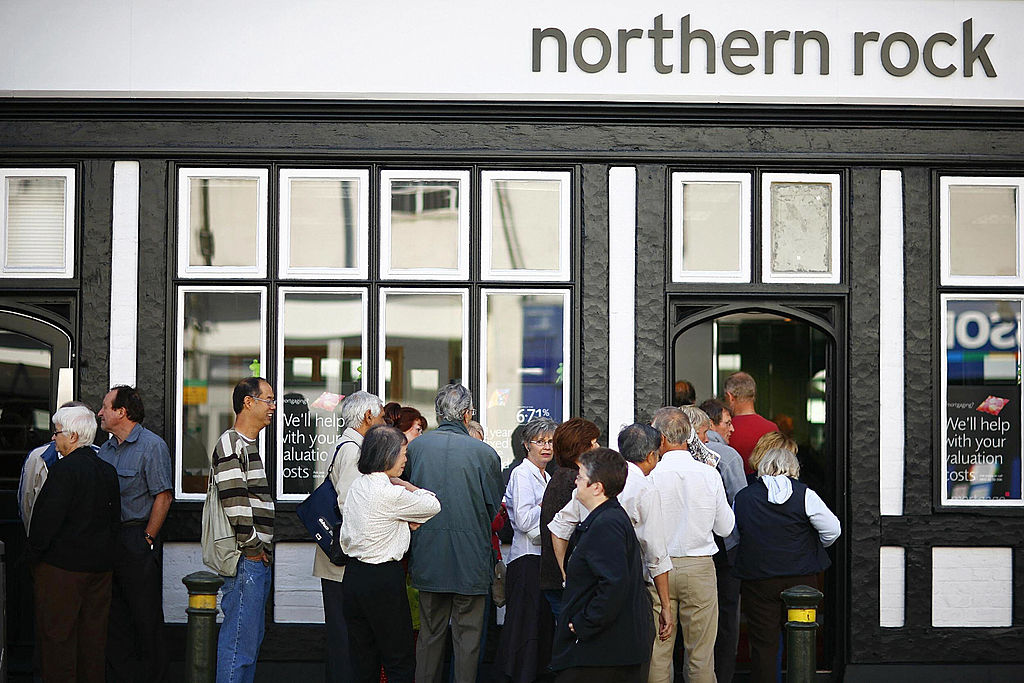 How have central banks evolved in the last century – and are they still fit for purpose?
How have central banks evolved in the last century – and are they still fit for purpose?The rise to power and dominance of the central banks has been a key theme in MoneyWeek in its 25 years. Has their rule been benign?
-
 Buying vs renting: is is better to own or rent your home?
Buying vs renting: is is better to own or rent your home?The higher mortgage rates of recent years have actually made renting comparatively cheaper, analysis suggests. But there are hidden costs to long term renting.
-
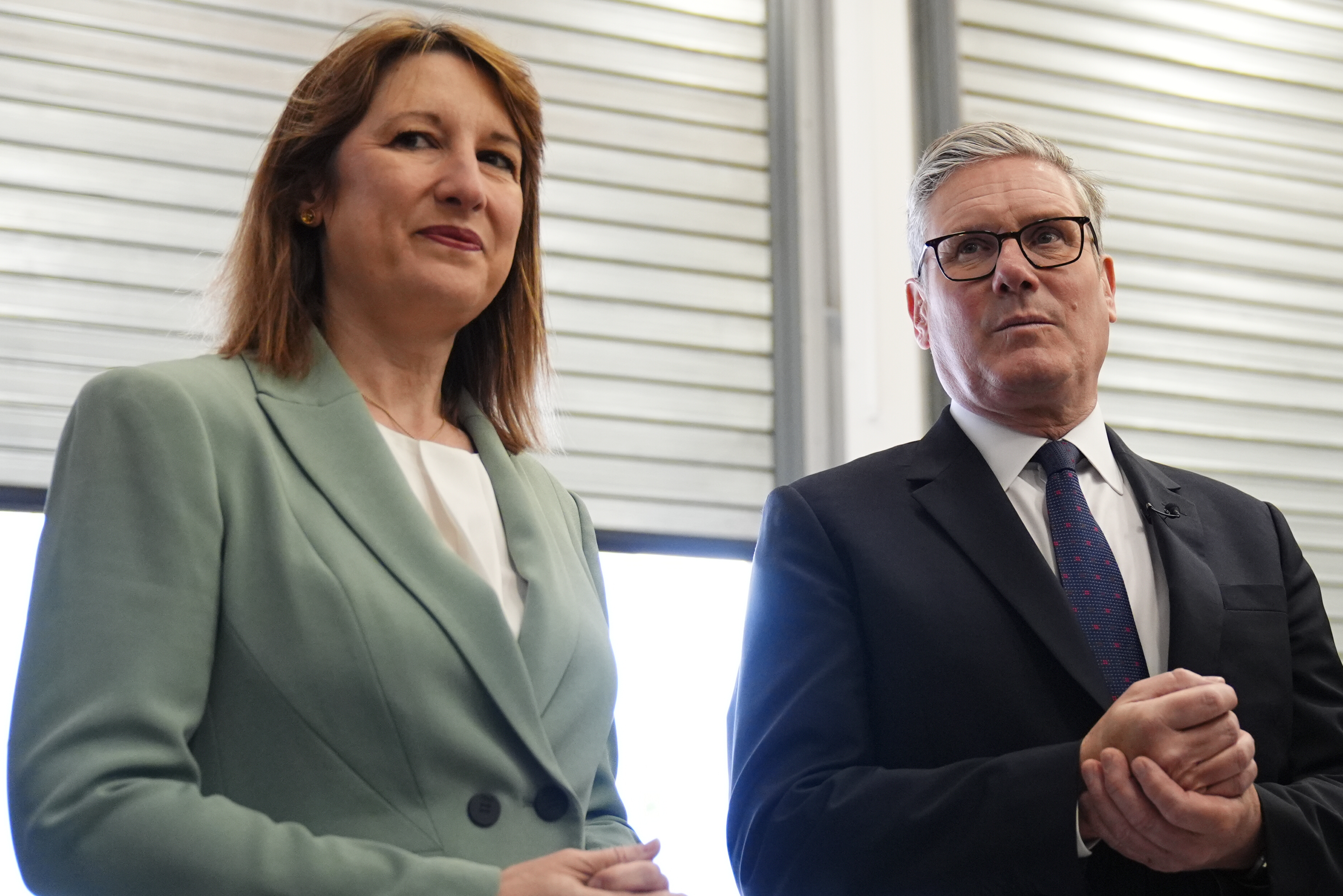 Is Britain heading for a big debt crisis?
Is Britain heading for a big debt crisis?Opinion Things are not yet as bad as some reports have claimed. But they sure aren’t rosy either, says Julian Jessop
-
 Why investors can no longer trust traditional statistical indicators
Why investors can no longer trust traditional statistical indicatorsOpinion The statistical indicators and data investors have relied on for decades are no longer fit for purpose. It's time to move on, says Helen Thomas
-
 How will markets react to the next Bank of England rate decision?
How will markets react to the next Bank of England rate decision?The Bank of England is due to announce its latest interest rate decision on Thursday, 2nd November, but how will markets react?
-
 Halifax: House price slump continues as prices slide for the sixth consecutive month
Halifax: House price slump continues as prices slide for the sixth consecutive monthUK house prices fell again in September as buyers returned, but the slowdown was not as fast as anticipated, latest Halifax data shows. Where are house prices falling the most?
-
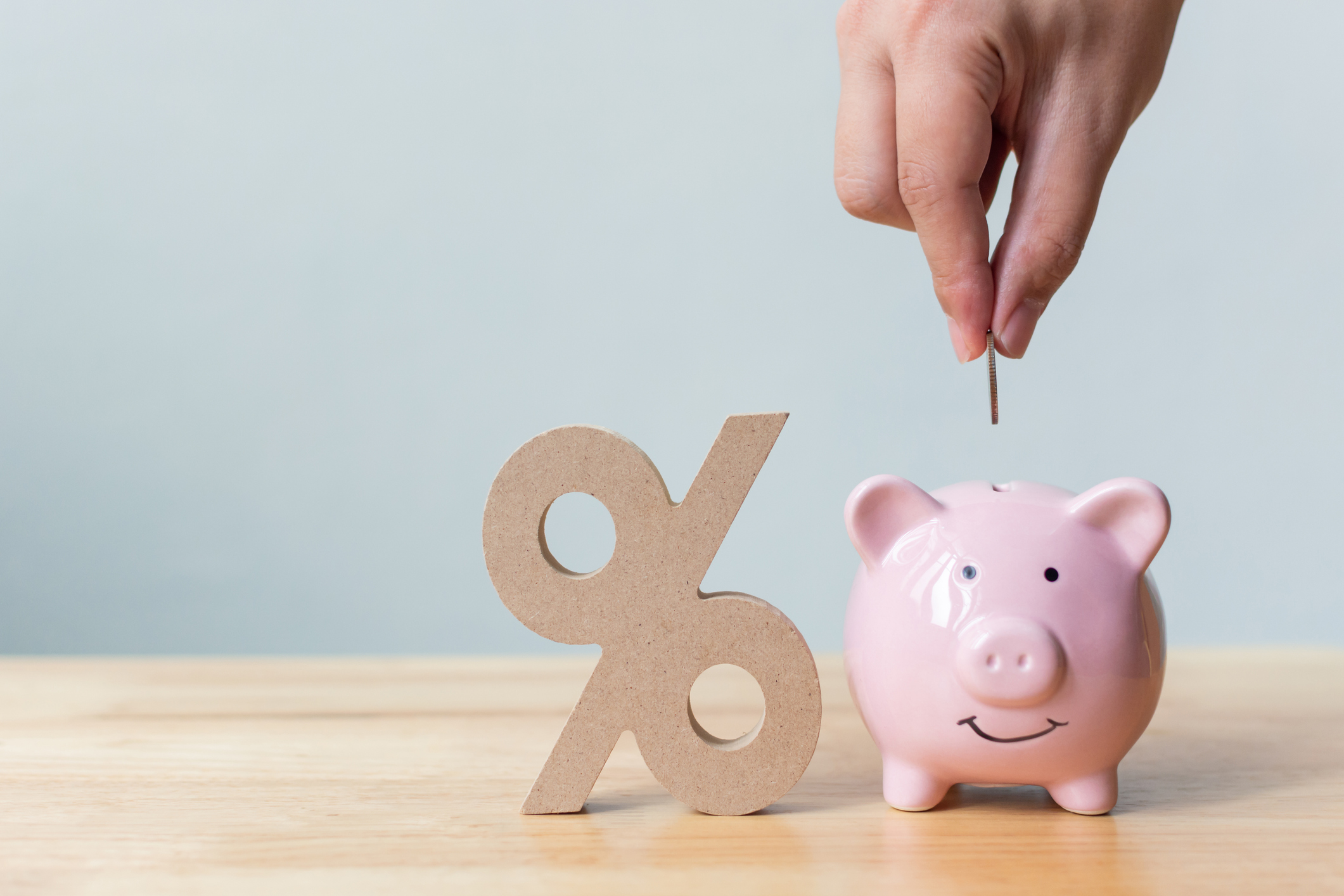 Retail bond paying 8.25% launches – should you buy it?
Retail bond paying 8.25% launches – should you buy it?A new bond from alternative property lender LendInvest looks eye-catching but how do retail bonds work, and what are the risks?